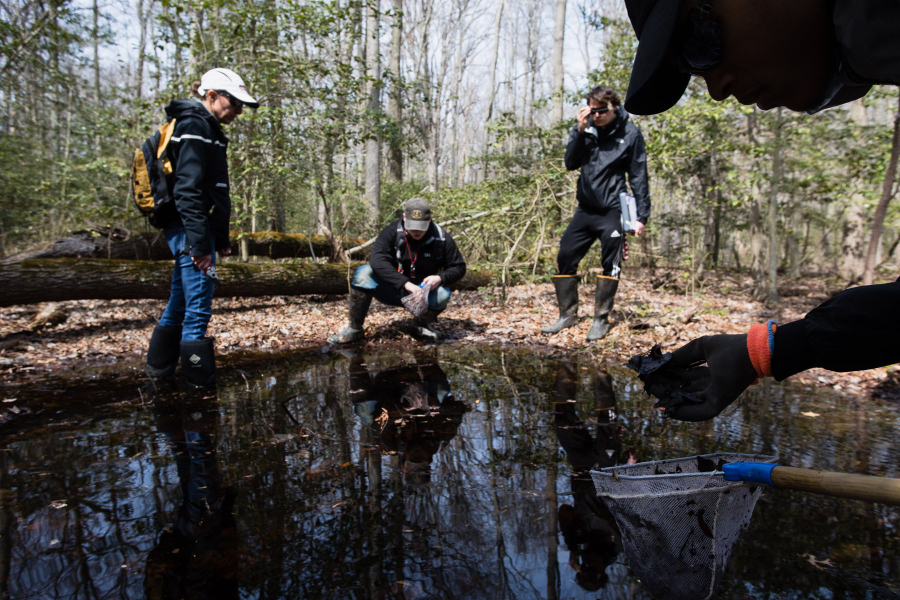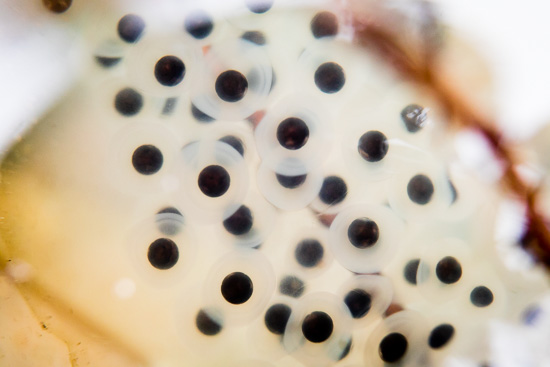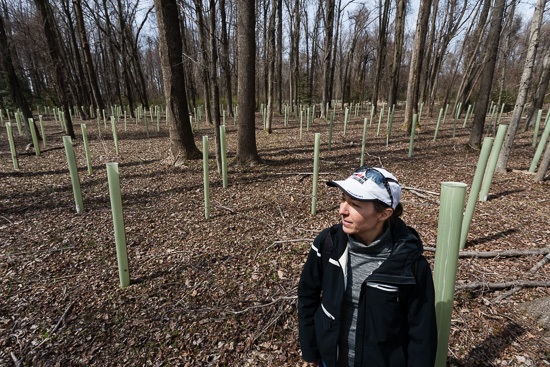How invasive species could be impacting salamander habitat
Investigating connection between invasives, groundwater and the vernal pools it supports

Within five minutes of entering Corcoran Woods, Susan Lamont is bent over what looks like a large puddle, gently holding a gelatinous mass. The mass is made up of salamander eggs, and what she’s bent over is no puddle, but a vernal pool.
Vernal pools are ephemeral forest ponds, fed by snow, rain or groundwater. They only stay wet for about seven months out of the year, but in that time, they host a wealth of animals. Amphibians like salamanders and frogs lay their eggs in vernal pools, which have fewer predators like fish due to their temporary nature.
Today, Lamont, a biology professor at Anne Arundel Community College, is leading a group of students and volunteers in a survey of vernal pools, looking for egg masses lain by spotted and marbled salamanders. They’re exploring the more than 200-acre Corcoran Environmental Study Area, which lies in Anne Arundel County, Maryland, just west of the Chesapeake Bay.
The southeastern section of Corcoran Woods is dotted with these temporary pools. Lamont breaks the students up into groups and shows them the pools they’ll be surveying. Armed with nets, boots and GPS markers, they begin scouring their pools for evidence of amphibian breeding.
Along with the surveying that her students and volunteers are doing, Lamont is setting traps for adult salamanders to help determine how they use the pools. In the past, she and her students would find adults by looking under rocks and logs. “I want to know how much they’re using the pools,” she says.
Now in her third year of the study, Lamont’s research not only answers her own questions and provides her students with an outdoor learning opportunity, it also serves the Maryland Department of Natural Resources (DNR), which owns Corcoran Woods. They were concerned about the vernal pools and if they were at risk of drying up. “If you’re managing the pools, you have to know what’s happening with them,” says Lamont. “They don’t have the staff to come out and do [the surveying], and it’s easy to get the students—they love it.”

About a half mile away, the northwest corner of the forest tells a different story. There are no vernal pools here, but there is an even more dramatic difference: this corner of the woods, unlike the southeast where Lamont’s students are surveying, is plagued by invasive species.
Much of the land was cleared of invasives last year, treated with herbicides and replanted with native trees. The hope is that the natives will grow large enough to shade the area and help keep invasives out. Until then, it will have to be carefully looked after to prevent regrowth of invasive species.
A slight turn in the trail reveals the vastly altered landscape. A forest of plastic tree tubes blankets the area of what used to be acres of invasive plants like oriental bittersweet, English ivy and multifloral rose. Some original trees still remain, but pale-green tubes stick out like hundreds of hair plugs.

“The red plot was severely infested,” recalls Lamont. “Before they treated it, all you could see were invasives. Vines were over the tops of the trees.” Thick vines still hung from a few of the remaining trees, but hovered about six feet above the ground where they had been severed from their roots.
Along with sunlight, invasive species require a lot of water, and in turn could have lowered the groundwater table. “This is a drier area than the vernal pool area,” Lamont notes. “We’re not sure if it’s drier because [the invasive species] were here, or if that’s why the invasives took over.” If the former is true, it could spell bad news for the vernal pools if the invasive species make their way south east.
Groundwater is generally talked about in terms of drinking water and irrigation, but forest plants and animals need it just as much as humans. In Corcoran Woods, groundwater is vital for feeding the vernal pools that salamanders and other amphibians rely on, but this corner of the woods is much drier and noticeably absent any pools.
That’s where Lamont’s new research comes in. She’s going to put groundwater monitoring wells in the area where the invasives are to see if the removal efforts make the area wetter. She’ll also put some groundwater wells in the vernal pool area to compare water levels within Corcoran Woods.
“[Maryland DNR is] very interested in protecting the pool habitat and restoring the part of the woods that was decimated by invasives,” Lamont says. By measuring the effect of invasive species on groundwater—and, in turn, the vernal pools the salamanders use—Lamont and her students can help DNR support the interconnected ecosystem at Corcoran Woods.

Comments
There are no comments.
Thank you!
Your comment has been received. Before it can be published, the comment will be reviewed by our team to ensure it adheres with our rules of engagement.
Back to recent stories